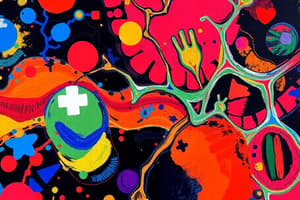Podcast
Questions and Answers
What is the primary function of eicosanoids in the body?
What is the primary function of eicosanoids in the body?
- To act as signaling molecules involved in inflammation and reproduction (correct)
- To store energy for metabolic processes
- To form the structural components of cell membranes
- To transport cholesterol through the bloodstream
How do certain drugs reduce inflammation and pain related to injury?
How do certain drugs reduce inflammation and pain related to injury?
- By directly neutralizing the inflammatory compounds
- By enhancing the production of leukotrienes
- By blocking the formation of prostaglandins and thromboxanes (correct)
- By increasing the activity of enzymes that convert lipids into cholesterol
Which structural feature enables lipoproteins to transport fats through the bloodstream?
Which structural feature enables lipoproteins to transport fats through the bloodstream?
- A rigid, crystalline form that prevents fat molecules from interacting with water
- A hydrophobic core with an amphipathic coat (correct)
- A structure composed only of lipids to dissolve fats easily
- A purely hydrophilic core that attracts water molecules
What is the primary role of chylomicrons?
What is the primary role of chylomicrons?
Which lipoprotein is responsible for transporting endogenous cholesterol from tissues back to the liver?
Which lipoprotein is responsible for transporting endogenous cholesterol from tissues back to the liver?
What property defines lipids as being hydrophobic?
What property defines lipids as being hydrophobic?
What is the primary function of storage lipids such as triglycerides?
What is the primary function of storage lipids such as triglycerides?
What is the key structural feature of phospholipids that allows them to form biological membranes?
What is the key structural feature of phospholipids that allows them to form biological membranes?
What is the basic structure of a phospholipid?
What is the basic structure of a phospholipid?
Which type of lipid is characterized by a structure containing a sugar group instead of a phosphate group?
Which type of lipid is characterized by a structure containing a sugar group instead of a phosphate group?
What is the fundamental structure of sterols?
What is the fundamental structure of sterols?
What is the role of cholesterol in eukaryotic cell membranes?
What is the role of cholesterol in eukaryotic cell membranes?
How is cholesterol transported in the blood?
How is cholesterol transported in the blood?
What is the primary function of cholesterol esters?
What is the primary function of cholesterol esters?
What is a consequence of LDL accumulation in the blood?
What is a consequence of LDL accumulation in the blood?
Which of the following describes the key role of HDL?
Which of the following describes the key role of HDL?
Which of the following is characteristic of atherosclerosis?
Which of the following is characteristic of atherosclerosis?
What is a common outcome of coronary arteries affected by atherosclerosis?
What is a common outcome of coronary arteries affected by atherosclerosis?
What is a primary characteristic of familial hypercholesterolemia?
What is a primary characteristic of familial hypercholesterolemia?
A defect in LDL receptors, leading to the inability to clear LDL from the blood, is a characteristic of which condition?
A defect in LDL receptors, leading to the inability to clear LDL from the blood, is a characteristic of which condition?
Flashcards
Eicosanoids
Eicosanoids
FA derivatives, act as paracrine hormones involved in reproduction, inflammation, fever, injury-related pain, and disease.
Prostaglandins
Prostaglandins
A class of eicosanoids that increase body temperature.
Thromboxanes
Thromboxanes
A class of eicosanoids involved in blood clot formation.
Leukotrienes
Leukotrienes
Signup and view all the flashcards
Lipoproteins Structure
Lipoproteins Structure
Signup and view all the flashcards
Chylomicrons
Chylomicrons
Signup and view all the flashcards
VLDL/LDL
VLDL/LDL
Signup and view all the flashcards
HDL
HDL
Signup and view all the flashcards
Lipids
Lipids
Signup and view all the flashcards
Lipid Categories
Lipid Categories
Signup and view all the flashcards
Fatty Acids
Fatty Acids
Signup and view all the flashcards
TAGs (Triacylglycerols)
TAGs (Triacylglycerols)
Signup and view all the flashcards
Structural Lipids
Structural Lipids
Signup and view all the flashcards
Phospholipids
Phospholipids
Signup and view all the flashcards
Glycerophospholipids
Glycerophospholipids
Signup and view all the flashcards
Sphingolipids
Sphingolipids
Signup and view all the flashcards
Sterols Function
Sterols Function
Signup and view all the flashcards
Cholesterol Esters
Cholesterol Esters
Signup and view all the flashcards
Atherosclerosis
Atherosclerosis
Signup and view all the flashcards
Family Hypercholesterolemia
Family Hypercholesterolemia
Signup and view all the flashcards
Study Notes
Other Lipids
- Eicosanoids are fatty acid derivatives and paracrine hormones.
- They play roles in reproduction, inflammation, fever, injury-related pain, and disease.
- There are 3 classes of eicosanoids: prostaglandins, thromboxanes, and leukotrienes.
- Prostaglandins increase body temperature.
- Thromboxanes are involved in blood clot formation.
- Leukotrienes are biological signals.
- Drugs can block the formation of prostaglandins and thromboxanes by inhibiting the enzyme involved in their conversion.
Lipoproteins
- Lipoproteins have a hydrophobic core with an amphipathic coat.
- They are spherical particles made of lipids and proteins that transport fats through the blood, which is water-based and doesn't dissolve fats.
- Chylomicrons are large, low-density lipoproteins that transport dietary triglycerides from the intestines to other tissues.
- VLDL/LDL (very low-density lipoprotein/low-density lipoprotein) are low to slightly higher density lipoproteins that transfer internally produced triglycerides and cholesterol from the liver to tissues.
- HDL (high-density lipoprotein) is a high-density lipoprotein that transports endogenous cholesterol from tissues to the liver
Lipids - General Information
- Lipids are organic molecules that are hydrophobic (low solubility in water).
- They play essential roles in energy storage, cell structure, and signaling.
- There are two categories of lipids: those that contain fatty acids and those that do not.
- Lipids that contain fatty acids are involved in storage and membrane structure.
- Lipids that do not contain fatty acids include cholesterol, vitamins, and pigments.
Fatty Acids
- Fatty acids are hydrocarbon derivatives.
- Fats and oils are used as stored forms of energy.
- They have a methyl end and a carboxylic acid end.
Storage Lipids
- TAGs (triglycerides/triacylglycerols) are energy storage molecules.
- They consist of 3 fatty acids attached to a glycerol backbone.
- They are hydrophobic and stored in anhydrous form, typically in adipose tissue.
Structural Lipids
- Structural lipids have polar head groups and nonpolar tails.
- They are structural components of membranes.
- The properties of the head group determine the surface properties of membranes.
Phospholipids
- Phospholipids consist of glycerol, 2 fatty acids, and a phosphate group.
- They can be either glycerophospholipids or sphingolipids.
Glycerophospholipids
- Glycerophospholipids are the most abundant lipids in membranes.
- They have hydrophobic and hydrophilic ends.
Sphingolipids
- Sphingolipids have a sugar group instead of a phosphate and polar group.
- They are membrane lipids with a long-chain amino alcohol called sphingosine.
- Fatty acids are joined to sphingosine via an amide linkage.
- Sugar-containing glycosphingolipids are largely found on the outer face of plasma membranes.
Ceramides
- Ceramide is the parent compound for the sphingolipid group.
Lipids that do not contain Fatty Acids
- Sterols have a nucleus of 4 fused rings.
- Cholesterol and sterols are found in membranes of eukaryotic cells but not in bacteria.
- They modulate fluidity and permeability of membranes and thicken the plasma membrane.
- Hormones are derivatives of sterols.
- Examples include bile acids, sex hormones, adrenal hormones, and vitamin D.
- Cholesterol is bound to proteins and transported to tissues via blood vessels. LDL can block arteries.
Cholesterol Esters
- Cholesterol is converted to esters for cell storage or transport in blood.
- Cholesterol esters are very water-soluble.
Cholesterol Transport
- HDL reduces cholesterol by removing it from tissues.
- LDL is considered "bad cholesterol"; when the amount needed for bile salts is surpassed, LDL accumulates in the blood vessels and causes plaques.
- HDL is considered "good cholesterol" because it picks up cholesterol from the blood and returns it to the liver; high levels are beneficial.
Diseases related to Cholesterol
- Atherosclerosis is hardening of the arteries.
- It is a progressive disease where lipids (cholesterol esters) deposit in smooth muscle cells.
- It forms lesions and calcified plaques that narrow or block arteries.
- Coronary arteries may cause heart attack.
- Cerebral arteries may cause stroke.
- Familial hypercholesterolemia is an inherited condition with high LDL levels.
- There is a defect in LDL receptors, so LDL cannot be cleared from the blood.
- Yellow skin nodules may form.
- Leads to accumulation of fats and swelling of artery walls.
- Treatment involves liver transplant or drugs.
Studying That Suits You
Use AI to generate personalized quizzes and flashcards to suit your learning preferences.




